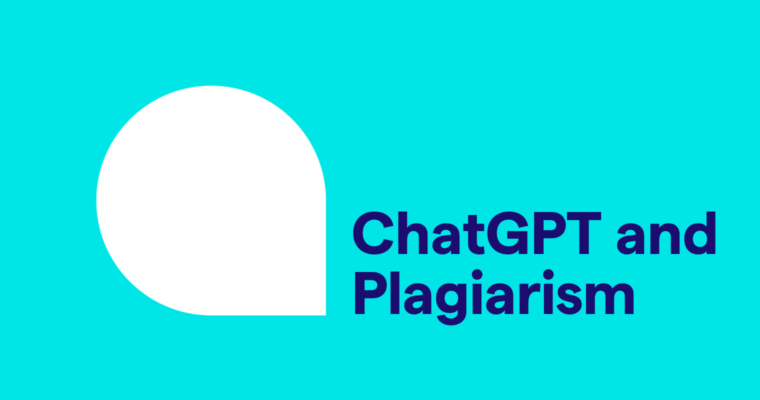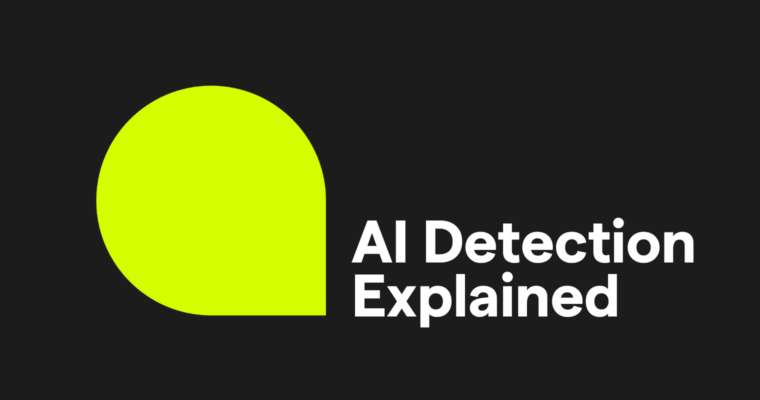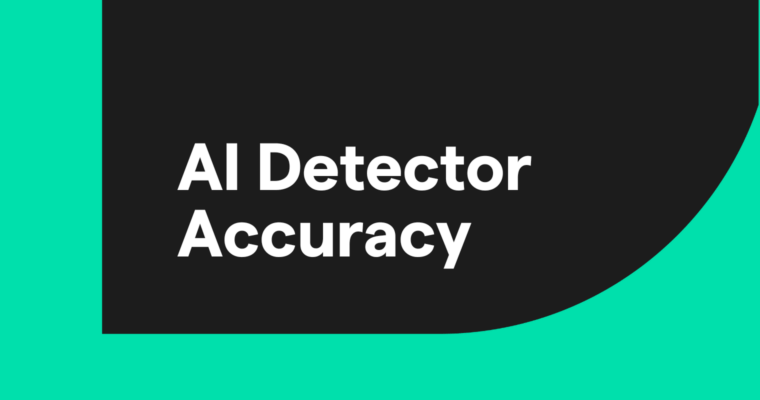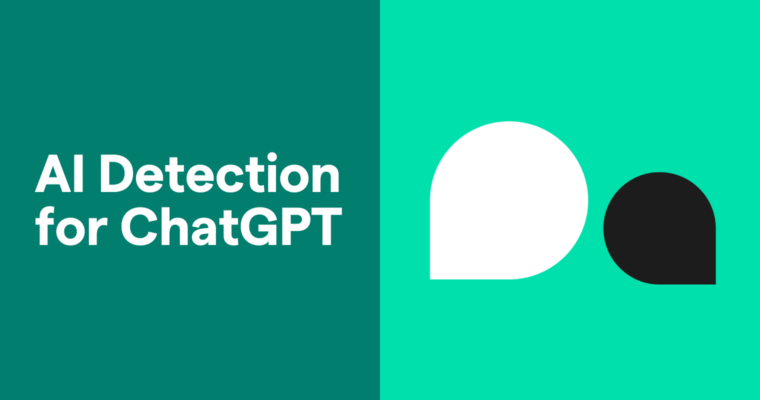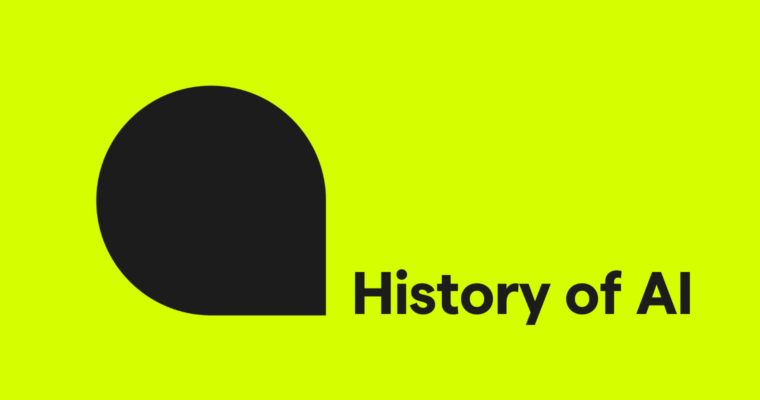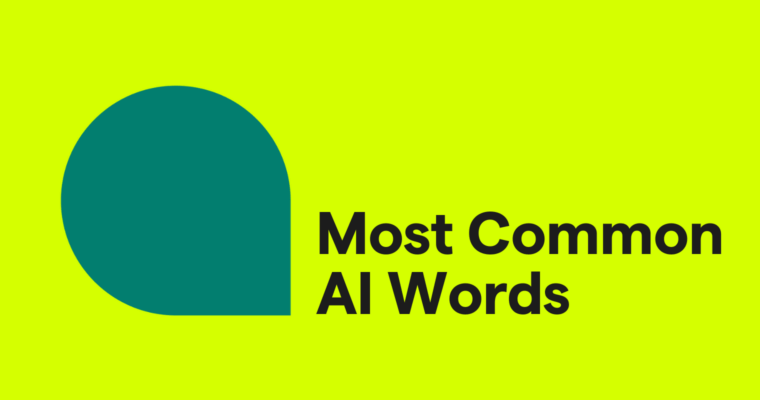
Key takeaways:
- AI-generated text often follows predictable patterns, such as a steady tone, repetitive phrasing, and structured transitions.
- Certain phrases, such as “delve into” and “at its core,” are common telltale signs and can make AI writing sound polished but stiff.
- Using AI responsibly means including human oversight in the workflows, adding transparency to the work, and properly citing sources and AI involvement.
Ever been invited to delve into a topic? Have you noticed pivotal decisions being underscored in recent blog articles? If so, you’ve probably read content that was developed with the support of AI. AI-generated text has come a long way—it’s fluent, structured, and often impressive. But it also tends to sound repetitive and robotic.
AI works best when you know how to guide and refine its output and use it in a responsible way. In this article, we’ll break down the most common signs of AI writing, highlight frequently used words and phrases, and explore how to use AI effectively while making sure human oversight plays a critical role.
Table of contents
Characteristics of AI-generated text
Commonly used words in AI-generated content
Ethical and responsible AI usage
What is AI-generated content?
AI-generated content refers to any text, image, video, audio, or other media created by artificial intelligence rather than a human.
For written content, AI-powered tools like Grammarly, ChatGPT, and Gemini generate text by analyzing vast datasets and responding to user prompts. These tools can produce fluent, well-structured copy that mimics human writing with impressive accuracy.
AI excels at organizing ideas, enhancing readability, and streamlining content creation, but it often lacks personality and creativity—things that make human writing feel, well, human.
Characteristics of AI-generated text
AI writing tends to follow distinct patterns, unlike human writing, which has more variation. Here’s what to look for to spot AI text in the wild:
- A formal, robotic tone – AI writing often sounds robotic because it tends to repeat the same sentence structure and often lacks emotion or nuance.
- Repetitive phrasing – Since AI generates words based on the patterns in its training data, it leans on familiar phrases, clichés, and even outdated language and information.
- A lack of personal touch – AI-generated content can make generalizations and quickly synthesize information, but it lacks personal stories, emotions, or unique perspectives.
- Predictable formatting – AI is great at structuring content—think title-case headings, neatly formatted bullet points, and polished phrasing.
Commonly used words in AI-generated content
Large language models (LLMs), such as GPT, generate text by predicting the most likely next word based on patterns learned from vast amounts of training data. Because of this predictive process, certain words and phrases tend to appear frequently in AI-generated content and can offer clues that the content was generated, rather than written by a person.
High-frequency AI words
AI-generated content sounds smart but feels generic because it relies on often-repeated formal words and phrases. Below are some of the most commonly used words in AI-generated writing—along with their meanings and simpler, more straightforward alternatives.
Delve into – To investigate or explore something deeply.
- Example: “Let’s delve into the history of AI.”
- Alternative: Explore
Underscore – To emphasize or highlight the importance of something.
- Example: “This study underscores the significance of ethical AI development.”
- Alternative: Highlight
Pivotal – Extremely important or crucial to the success of something.
- Example: “Machine learning plays a pivotal role in modern automation.”
- Alternative: Important
Realm – A field, domain, or area of interest or activity.
- Example: “This concept belongs to the realm of computational linguistics.”
- Alternative: Area
Harness – To make use of something effectively, especially a resource or power.
- Example: “Businesses harness AI to improve customer service.”
- Alternative: Use
Illuminate – To explain, clarify, or make something easier to understand.
- Example: “This guide aims to illuminate the complexities of neural networks.”
- Alternative: Explain
Transitions and structured phrases
AI is great at organizing content and it often relies on a few transitional phrases to help readers follow along. While these phrases sometimes help with clarity, they’re often needlessly wordy and can signal the use of AI.
Below are some of the transition phrases AI tends to use—along with more concise or colloquial alternatives.
That being said… – A phrase used to introduce a contrasting point or qualification after making a statement.
- Example: “AI tools can significantly improve efficiency. That being said, they should be used responsibly to avoid ethical concerns.”
- Alternative: However…/Even so…
At its core… – A phrase used to summarize the fundamental essence of something.
- Example: “At its core, machine learning is about recognizing patterns in data to make informed predictions.”
- Alternative: Fundamentally…/Essentially…
To put it simply… – A phrase used to break down a complex concept into a more digestible explanation.
- Example: “To put it simply, deep learning mimics the way the human brain processes information.”
- Alternative: In simpler terms…/Simply put…
This underscores the importance of… – A phrase used to emphasize a significant takeaway or conclusion.
- Example: “AI’s ability to process vast amounts of data in seconds underscores the importance of integrating it into business strategies.”
- Alternative: This highlights the need for…/This reinforces the value of…
A key takeaway is… – A phrase used to summarize an essential point or conclusion.
- Example: “A key takeaway is that AI should complement human intelligence rather than replace it.”
- Alternative: The main point is…/One important lesson is…
From a broader perspective… – A phrase used to introduce a more high-level or holistic viewpoint.
- Example: “From a broader perspective, AI is reshaping industries beyond technology, influencing healthcare, finance, and education.”
- Alternative: When you zoom out…/On a larger scale…
Qualifiers and softening words
AI-generated writing often plays it safe by using hedging phrases—words that soften statements to avoid sounding too absolute. While this can help maintain neutrality and prevent overgeneralization, it can also convey a hesitant or cautious tone.
Below are some of the most common hedging phrases AI tends to use—along with their meanings, examples, and more confident alternatives. In many of the following cases, simply removing the qualifying phrase altogether or trading it for a more specific claim or quote can make the writing feel more authoritative.
Generally speaking – Used to introduce a statement that is true in most cases but may have exceptions.
- Example: “Generally speaking, machine learning models perform better with larger datasets.”
- Alternative: In most cases…/As a rule…
Typically – Indicates that something is common or expected in most situations.
- Example: “Neural networks typically require large amounts of labeled data to train effectively.”
- Alternative: Usually…/Most often…
Tends to – Suggests a recurring pattern or behavior without making an absolute statement.
- Example: “AI-generated content tends to be more structured and uniform than to human writing.”
- Alternative: Is often…/Has a tendency to…
Arguably – Signals that a statement is open to interpretation or debate.
- Example: “AI is arguably one of the most transformative technologies of the 21st century.”
- Alternative: Some may say…/Technologists agree…
To some extent – A phrase that limits the scope of a claim, indicating partial truth.
- Example: “To some extent, AI can replicate human creativity, but it still lacks genuine originality.”
- Alternative: To a certain degree…/Partially…
Broadly speaking – Used to introduce a generalization while acknowledging that details may vary.
- Example: “Broadly speaking, AI improves efficiency across industries, but its impact depends on the specific application.”
- Alternative: In a general sense…/Overall…
Analytical and academic words
AI-generated writing often leans on analytical and academic language to sound more sophisticated, which can also make it sound overly formal or impersonal. Look out for the following academic words AI tends to favor and consider more natural alternatives.
Shed light on – To clarify or provide a deeper understanding of a topic.
- Example: “The study sheds light on the long-term effects of AI in education.”
- Alternative: Explain/Clarify
Facilitate – To make a process easier, smoother, or more efficient.
- Example: “AI-powered chatbots facilitate customer service by handling routine inquiries automatically.”
- Alternative: Help/Enable
Refine – To make gradual improvements by making small adjustments.
- Example: “Developers continually refine language models to improve their accuracy and relevance.”
- Alternative: Improve/Enhance
Bolster – To strengthen, support, or reinforce something.
- Example: “Real-time analytics bolster business decision-making by providing data-driven insights.”
- Alternative: Support/Reinforce
Differentiate – To identify or establish distinctions between two or more things.
- Example: “Advanced AI models can differentiate between writing styles and patterns, identifying characteristics commonly associated with AI-generated and human-written text…”
- Alternative: Distinguish/Tell apart
Streamline – To make a process simpler, more efficient, or less complicated.
- Example: “Automation streamlines workflow management, reducing manual tasks and increasing productivity.”
- Alternative: Simplify/Optimize
Overused AI buzzwords
AI-generated content often leans on flashy buzzwords or clichés to sound more impressive. While these words are meant to add energy, they’ve become so overused that they risk losing meaning and may make claims sound exaggerated.
Consider trading the following common AI buzzwords for more specific language—or editing them out completely to make the writing more incisive and impactful. Often, adjectives such as “innovative” or “cutting-edge” serve as filler words and lack meaning. Instead of simply describing something as innovative, consider including specifics that convey that more vividly. Read on to discover other clichés AI tends to use along with less-used alternatives.
Revolutionize – To completely change or disrupt an industry, process, or way of doing things.
- Example: “AI-powered automation is set to revolutionize the way businesses handle customer service.”
- Alternative: Transform/Change significantly
Innovative – Describing something as new, creative, or unique in its approach.
- Example: “This innovative machine learning model enhances speech recognition accuracy.”
- Alternative: New/Creative/or cut entirely
Cutting-edge – At the forefront of technology, representing the latest advancements.
- Example: “Cutting-edge AI algorithms enable real-time data analysis with unparalleled efficiency.”
- Alternative: Advanced/State-of-the-art/or cut entirely
Game-changing – Having a major impact that alters how something functions or operates.
- Example: “AI-driven cybersecurity solutions are a game-changing development in threat detection.”
- Alternative: Significant/Groundbreaking/or cut entirely
Transformative – Causing a major shift or improvement in a field or industry.
- Example: “Deep learning has had a transformative effect on natural language processing.”
- Alternative: Impactful/dramatically changed
Seamless integration – The smooth incorporation of a system, tool, or feature without disruptions.
- Example: “The platform offers seamless integration with existing enterprise software.”
- Alternative: Smooth compatibility/Works effortlessly with…
Scalable solution – A product or system that can easily grow to handle increased demand.
- Example: “Cloud-based AI provides a scalable solution for businesses of all sizes.”
- Alternative: Expandable system/Easily adjustable
Tips for ethical and responsible AI use
AI tools offer valuable writing assistance, but they require a thoughtful, collaborative approach to get the best results. Rather than simply generating text, learn how to co-create with AI so that your creativity and originality remain at the core of your work—and don’t forget to cite when you use AI just as you would any other source. Read on for more ways to integrate AI effectively while keeping your writing authentic and trustworthy.
Track your writing process
Rather than relying on AI detection tools that only estimate AI involvement, Grammarly Authorship allows you to track your writing process proactively. Simply turn on Authorship before you start working in a Google Doc, and it will automatically track and categorize your writing—whether it’s fully self-authored, created with AI assistance, or pasted from another source. By tracking how you work with AI, you can remove ambiguity and demonstrate integrity in your content creation.
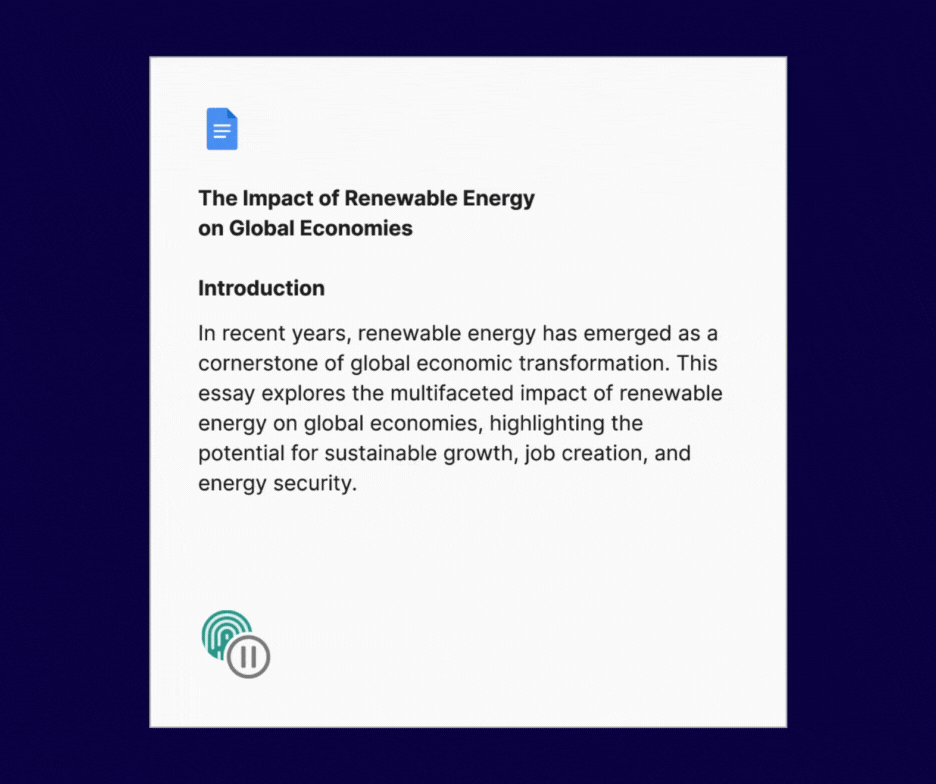
Be transparent about AI’s role
Transparency builds trust with your audience and helps set clear expectations. Grammarly’s AI citation generator in APA, MLA, and Chicago formats makes it easy to cite your use of AI.
Keep human oversight at the center
AI is a powerful tool, but it’s not a substitute for human judgment. Always review and refine AI-generated text to ensure it aligns with your intent, maintains your voice, and meets your quality standards. Thoughtful editing transforms AI’s structured but sometimes stiff output into something polished and uniquely yours.
Use AI to enhance, not replace, creativity
While AI can help organize ideas and streamline writing, relying on it too much can make content sound generic. Instead of letting AI dictate your message, use it as a starting point. Add your own insights, experiences, and personal style to make your writing feel more natural and engaging. AI should help you work more efficiently—not take over the creative process.
Follow industry and institutional guidelines
Different fields have different standards for AI use. If you’re writing for work, school, or publication, make sure you understand the expectations around AI-assisted writing. When required, properly cite AI-generated content just as you would any other source. Responsible AI use isn’t just about following the rules—it’s about ensuring your writing is both transparent and credible.
Conclusion
AI tools make writing more efficient, but they often produce text that feels robotic. Recognizing AI’s patterns—like repetitive phrasing and predictable transitions—can help you refine its output and keep your writing natural. Using AI responsibly means maintaining transparency, ensuring human oversight, and following ethical guidelines.
Grammarly helps you reap the benefits of AI while maintaining your creativity, unique voice, and integrity. With features like Grammarly Authorship, you can track AI’s role in your writing, while AI-powered suggestions enhance clarity, tone, and structure. By combining AI’s efficiency with human creativity, you can create high-quality, authentic writing that feels both polished and personal.
Common AI words list FAQs
How can you tell if text was generated by AI?
AI-generated writing tends to follow predictable patterns—a formal or robotic tone, repetitive phrasing, and structured transitions. It also leans on certain words, like delve into, underscore, and pivotal. Tools like Grammarly’s AI Detector can analyze content for AI-generated patterns and help you spot text that may require editing.
Are AI detection tools reliable?
AI detection tools can estimate the likelihood that a piece of text was AI-generated, but they’re not 100% foolproof. Accuracy depends on many factors such as how advanced the AI model is and how the text was edited or refined.
Why does AI writing sound overly formal or structured?
AI models are trained on massive datasets, which helps them mimic text. While the output is often clear and well-structured, it usually lacks the nuance of human expression, making it sound formal, predictable, or formulaic.
Can AI-generated content be refined to sound more human?
Yes! Human oversight can make AI-generated text more natural and engaging. Try the following strategies when editing AI content:
- Add personal insights or anecdotes.
- Adjust the tone and style.
- Trade formulaic structures for something more surprising or original.
How can writers use AI responsibly?
Responsible AI use means keeping human creativity and judgment at the center. To do this, review and refine AI-generated content to ensure it aligns with your voice and intent. Be transparent about AI’s role in your writing, just as you would cite other sources. And use tools like Grammarly Authorship to track AI’s contributions, providing clarity and credibility in content creation.

